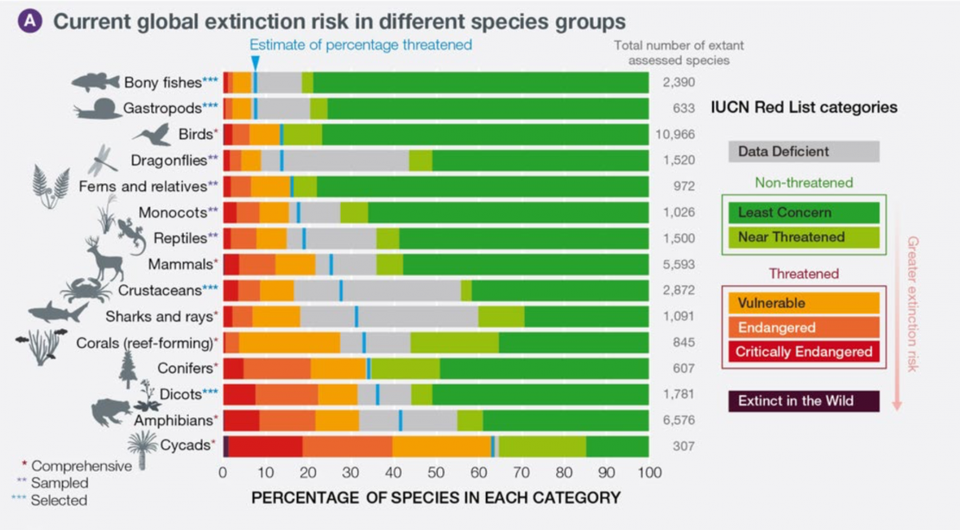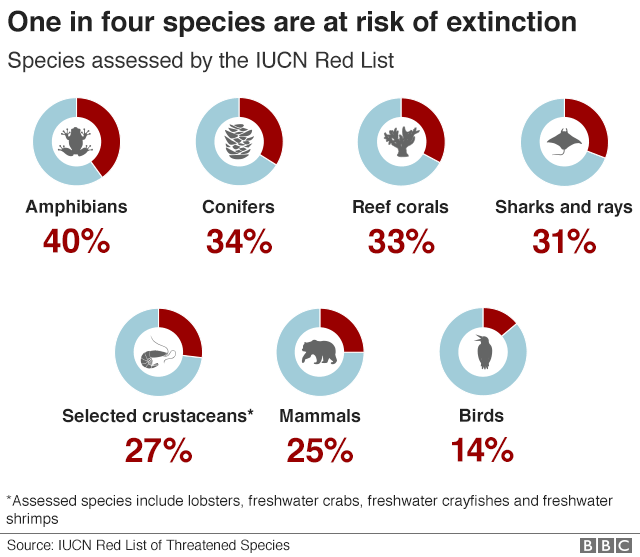Extinction & Animals
According to the new Report, entitled Intergovernmental Science-Policy Platform on Biodiversity and Ecosystem Services (IPBES), more than one million species of plants and animals are at risk of extinction - many of which are predicted to be pushed into extinction within just a few decades.
The Report found that more than 40% of amphibian species, almost 33% of reef-forming corals and more than a third of all marine mammals are threatened, and at least 680 vertebrate species had been driven to extinction since the 16th century. Scientists warn of 'ecological Armageddon' after study shows flying insect numbers plummeting 75% in protected areas.
When a plant or animal species that once lived stops existing entirely, we say that that species has become extinct.
Unlike past mass extinctions, caused by events like asteroid strikes, volcanic eruptions, and natural climate shifts, the current crisis is almost entirely caused by us — humans. It may be the fastest one ever with a rate of 1,000 to 10,000 times the baseline extinction rate of one to five species per year. In fact, 99 percent of currently threatened species are at risk from human activities, primarily those driving habitat loss, introduction of exotic species, and global warming.
About 75% of land and 66% of ocean areas have been “significantly altered” by people, driven in large part by the production of food, according to the IPBES report. Crop and livestock operations currently co-opt more than 33% of Earth’s land surface and 75% of its freshwater resources.
The truth is, scientists don’t know how many species of plants, animals, fungi, and bacteria exist on Earth. The most recent estimate put that number at 2 billion, and that will most likely change at some point.
To date, about 1.5 million species have been formally described in the scientific literature, most of them insects. Proportionally, bacteria comprise less than 1% of all described species.
Scientists generally agree that many more species exist than are formally described, but they disagree about how many there really are. Some studies have estimated 2 million or fewer, whereas others suggest as many as 12 million.
Other notable findings of the Report include:
Three-quarters of the land-based environment and about 66% of the marine environment have been significantly altered by human actions. On average these trends have been less severe or avoided in areas held or managed by Indigenous Peoples and Local Communities.
More than a third of the world’s land surface and nearly 75% of freshwater resources are now devoted to crop or livestock production.
The value of agricultural crop production has increased by about 300% since 1970, raw timber harvest has risen by 45% and approximately 60 billion tons of renewable and nonrenewable resources are now extracted globally every year – having nearly doubled since 1980.
Land degradation has reduced the productivity of 23% of the global land surface, up to US$577 billion in annual global crops are at risk from pollinator loss and 100-300 million people are at increased risk of floods and hurricanes because of loss of coastal habitats and protection.
In 2015, 33% of marine fish stocks were being harvested at unsustainable levels; 60% were maximally sustainably fished, with just 7% harvested at levels lower than what can be sustainably fished.
Urban areas have more than doubled since 1992.
Plastic pollution has increased tenfold since 1980, 300-400 million tons of heavy metals, solvents, toxic sludge and other wastes from industrial facilities are dumped annually into the world’s waters, and fertilizers entering coastal ecosystems have produced more than 400 ocean ‘dead zones’, totaling more than 245,000 km2 (591-595) - a combined area greater than that of the United Kingdom.
Negative trends in nature will continue to 2050 and beyond in all of the policy scenarios explored in the Report, except those that include transformative change – due to the projected impacts of increasing land-use change, exploitation of organisms and climate change, although with significant differences between regions.
About one million species of animals and plants around the world are now at risk of extinction, in part due to pollution and over-fishing. A new United Nations report says nature is essential for our existence and a good quality of life, but point to a stark warning: humans are transforming the planet’s natural habitat at an unprecedented rate. Jonathan Vigliotti reports.
IUCN Red List
Established in 1964, The International Union for Conservation of Nature’s Red List of Threatened Species has evolved to become the world’s most comprehensive information source on the global conservation status of animal, fungi and plant species.
The IUCN Red List is a critical indicator of the health of the world’s biodiversity. Far more than a list of species and their status, it is a powerful tool to inform and catalyze action for biodiversity conservation and policy change, critical to protecting the natural resources we need to survive. It provides information about range, population size, habitat and ecology, use and/or trade, threats, and conservation actions that will help inform necessary conservation decisions.
Highly Endangered Species
The list of endangered species is getting bigger by the day. More than 27,000 species are threatened with extinction. That is more than 27% of all assessed species.
Here are a few highlighted to get an impression.
Amur leopard
The Amur leopard is one of the world's most endangered wildcats, and native to the Russian Far East. This subspecies — which is also known as the Far East leopard, the Manchurian leopard, or the Korean leopard, despite being nearly extinct outside of the Amur River basin in eastern Russia — can run upwards of 37 miles an hour and jump as high as 19 feet in the air. According to a 2015 census, there are only around 60 Amur leopards left, all living at Russia's Land of the Leopard National Park. That list is now updated to 40.
We are treated to intimate footage of the rarest Cat on Earth, the Amur Leopard. Winter is a difficult time for this hunter - there are no leaves for cover and no young prey animals. It comes as little surprise that there are only 40 of these magnificent Cats left in the wild and the numbers are sadly falling.
Bornean orangutan
In the past 60 years, there has been a 50% decline in the Bornean orangutan population.
Scientists predict that by 2025, there will only be 47,000 Bornean orangutans. Found only on the island of Borneo, Asia's largest island, Bornean orangutans have broader faces and shorter beards than their arboreal Sumatran cousins.
The most threatened is the Northeast subspecies: due to its habitat being decimated by logging and hunting, there are only about 1,500 extant Northeast Borean apes.
Scientists predict that the Bornean orangutan population will fall another 22% by 2025, bringing the total number down to 47,000.
Footage recently released by International Animal Rescue, shows harrowing footage of an orangutan trying to fight off a bulldozer destroying its habitat. As loggers smash the base of a tree in the Ketapang District, West Borneo, heart-breaking video shows one of the great apes perched in the tree's canopy as it falls to the floor.
Gorillas
It was once believed that mountain gorillas would be extinct by the end of the 20th century.
At just under 900, the current population size is low, but conservationists are working to ensure that mountain gorillas don't fall prey to human threats.
According to the African Wildlife Foundation, the greatest threats to mountain gorillas— an eastern gorilla subspecies — are political instability (mainly conflicts in the Democratic Republic of Congo), human encroachment, and forest degradation.
The remaining mountain gorilla population is spread out over three countries and four national parks, such as Bwindi Impenetrable National Park in Uganda, and Virunga National Park in DRC.
Hawksbill Turtles
Despite their international protected status, hawksbill turtles are killed for their prized shells.
This sea turtle is found in tropical oceans around the world.
Humans pose a large threat to hawskbills, whose population has decreased by 80% over the last century. Despite their protected status under the Convention on International Trade in Endangered Species of Wild Fauna and Flora, people still eat their eggs and kill them for their flesh and colorful shells. They're also susceptible to being ensnared in fishing nets.
South China tiger
Back in the 1950s, there were an estimated 4,000 South China tigers. Although China banned poachers from hunting these wildcats in 1979, the population dipped to between 30 and 80 by the end of the 20th century.
About 100 tigers remain in captivity, reported in 2016.
Sumatran elephant
The Sumatran elephant thrives in lush forests and can weigh up to five tons.
In 2012, the species was categorized as "critically endangered" by the WWF. Due to habitat decimation, half of its population was lost over the course of one generation, and the WWF estimates that between 2,400 and 2,800 remain.
Mass extinctions are relatively rare events; however, isolated extinctions are quite common. Only recently have extinctions been recorded and scientists have become alarmed at the current high rate of extinctions. Most species that become extinct are never scientifically documented. Some scientists estimate that up to half of presently existing plant and animal species may become extinct by 2100.
Black Rhinos
The number of black rhinos in Africa has decreased dramatically in the past century. Fewer than 2,500 black rhinos existed in 1995, a 98% drop compared to 1960. The black rhino population has increased somewhat since then, and there are 5,000-5,400 black rhinos in the world today.
However, poaching and trafficking of rhino horns still prevents the species from recovering to early 20th-century levels. The WWF says rhinos are some of the oldest mammals in the world, and efforts to protect them benefit other species too, including elephants.
Mammals
96% of the mass of mammals on our planet today are us, and the livestock that we’ve domesticated.
According to the International Union for Conservation of Nature (IUCN), 1169 of the world's 4556 assessed terrestrial mammals (approx. 26%) are listed as threatened with extinction. Here, using individual species accounts from the IUCN Red List, we identify 301 threatened mammal species for which a primary threat is hunting by humans.
Only 4% is everything else. 70% of all birds are now domesticated poultry, mostly chickens.
Given the current rate of extinction, we’ll lose even more mammals in the next 50 years, and it’ll take 3 to 5 million years to once again reach today’s biodiversity levels. If we want to go back to the level of mammal diversity that existed before our species, that will take 5 to 7 million years. Plus, since big body sizes develop more slowly than small ones, it will take even longer to recover the loss of diversity in large mammals like mammoths that occurred between 2,000 and 50,000 years ago.
Every year, more and more animals are in serious danger of going extinct! But have you ever stopped and wondered, what causes animals to go extinct in the first place?
Reasons
By a wide margin, the top two are (1) land and sea use, including development, logging, mining and harvesting, and (2) hunting and fishing for food or for trade in body parts.
Perhaps surprisingly, global climate change is third on this list, but considering that, since 1980, greenhouse gas emissions have doubled, and thereby raised average global temperatures by at least 0.7 degrees Celsius, its damaging impacts are expected to move up the list in importance -- and very quickly. Already we know that climate change is aggravating the damaging effects of overfishing, pesticide use, pollution, and urban expansion into natural spaces. The Report documented that warming climate is impacting nature at all levels, from ecosystems to genetics -- and those impacts are expected to increase dramatically over the coming decades.
Fourth and fifth on this list are pollution and invasive alien species. The report notes that 400 million tons of heavy metals, toxic sludge and other wastes are dumped into oceans and rivers every year, and invasive alien species, such as rats, mosquitoes, snakes and plants that hitchhike on ships or airplanes are becoming more widespread.
About 66 million years ago, a terrible extinction event wiped out the dinosaurs. But it wasn’t the only event of this kind -- extinctions of various severity have occurred throughout the Earth’s history -- and are still happening all around us today.
Solutions
1. Spread the word, to your family, friends, co-workers, and social media circle: the extinction crisis is real. Mobilizing a critical mass of people is the first step.
2. Reduce your carbon footprint. Especially in developed countries, reducing the per-capita use of fossil fuels will be essential for holding climate change below lethal thresholds for many species globally. You can assess and figure out ways to lower your carbon footprint by using one of the many on-line carbon footprint calculators (like carbonfootprint.com). Even little changes like adjusting the thermostat; trip-chaining (go from one errand to the next) when you use your car for errands; recycling; and walking or biking instead of driving, when multiplied by hundreds of millions of the world’s most prolific consumers, add up to huge results.
3. Buy products from companies committed to using sustainably produced palm oil in their products. Palm oil is an ingredient in many foods, cosmetics, and soaps. But tropical forests, which harbor up to two-thirds of all land species, are rapidly being cut down to make way for palm-oil plantations. Some companies that use palm oil in their products have committed to not using oil that originates from newly deforested landscapes — these are the companies to buy from. The Union of Concerned Scientists provides a list.
4. Avoid eating fish. Overfishing has wiped out 90 percent of the big fish from the sea and caused near-extinction of many species. An easy way to make sure the fish you buy are from healthy stocks is to use the Monterey Bay Aquarium’s Seafood Watch App, which you can find at here.
5. Stop meat consumption . If lands now used to grow crops for livestock were instead used to grow crops eaten directly by people, there would be 50 to 70 percent more calories available for human consumption. Which is enough to feed more than a billion more people than we’re feeding today, and would prevent plowing over rainforests to make more farms.
6. Vote for and support leaders who recognize the importance of switching from a fossil-fuel energy system to a carbon-neutral one, who see the necessity of growing crops more efficiently, whose economic agenda includes valuing nature, and who promote women’s rights to education and healthcare.
What do you do to maintain biodiversity? By tagging us with #theconsciouschallenge you can share your ideas!
Want to contribute to our Ecological Footprint Bible? Submit us your scientific articles! Mail us at info@theconsciouschallenge.org
https://journals.plos.org/plosone/article?id=10.1371/journal.pone.0185809
https://www.forbes.com/sites/grrlscientist/2019/05/09/un-report-1-million-animal-and-plant-species-at-risk-of-extinction/#1b44bb8d5fa3
https://www.britannica.com/science/extinction-biology
https://www.worldwildlife.org/stories/amur-leopard-world-s-rarest-cat-doubles-in-population
https://www.worldwildlife.org/species/directory?sort=extinction_status&direction=desc
https://www.biologicaldiversity.org/programs/biodiversity/elements_of_biodiversity/extinction_crisis/
https://www.popularmechanics.com/science/animals/g20955197/animals-almost-extinct/
https://edition.cnn.com/2018/10/07/world/climate-change-new-ipcc-report-wxc/index.html
https://www.ipbes.net/news/Media-Release-Global-Assessment
https://www.thoughtco.com/animal-extinction-overview-127885
https://www.bbc.com/news/science-environment-48169783
https://news.nationalgeographic.com/2016/06/first-mammal-extinct-climate-change-bramble-cay-melomys/
https://edition.cnn.com/2019/02/20/australia/mammal-climate-change-extinction-intl-trnd/index.html
https://www.forbes.com/sites/priyashukla/2019/02/22/this-is-the-first-mammal-that-climate-change-has-officially-driven-to-extinction/#10d2aa321d6e
https://www.cbsnews.com/news/report-1-million-animals-plant-species-face-extinction-due-climate-change-human-activity-population/
https://www.cbsnews.com/news/adapt-or-die-cbsn-originals/
https://www.npr.org/2019/05/06/720654249/1-million-animal-and-plant-species-face-extinction-risk-u-n-report-says
https://www.nbcnews.com/mach/science/1-million-species-under-threat-extinction-because-humans-report-finds-ncna1002046
https://www.nytimes.com/2012/06/03/opinion/sunday/are-we-in-the-midst-of-a-sixth-mass-extinction.html?_r=0
https://www.iucnredlist.org/
https://eu.usatoday.com/story/opinion/2019/05/11/zoos-aquariums-can-help-save-one-million-species-extinction-column/1152477001/
https://www.nature.com/articles/d41586-019-01448-4
https://www.nationalgeographic.com/animals/2018/10/millions-of-years-mammal-evolution-lost-news/
https://www.pnas.org/content/115/44/11262
https://www.sciencemag.org/news/2019/06/twice-many-plants-have-gone-extinct-birds-mammals-and amphibians-combined
https://phys.org/news/2018-10-mammals-evolve-fast-current-extinction.html
https://royalsocietypublishing.org/doi/full/10.1098/rsos.160498
https://www.forbes.com/sites/deloitte/2019/05/01/transforming-the-balance-sheet-navigating-new-lease-standards-for-success/#db89d856dad9
https://edition.cnn.com/2019/05/06/world/one-million-species-threatened-extinction-humans-scn-intl/index.html
https://www.nationalgeographic.com/animals/reference/extinction-wild-endangered-species/
https://www.insider.com/endangered-animals-2018-3#the-arboreal-alligator-lizard-found-mainly-in-the-forests-of-central-america-is-threatened-by-continual-habitat-destruction-23
https://www.businessinsider.nl/koalas-functionally-extinct-in-australia-2019-5/?international=true&r=US


